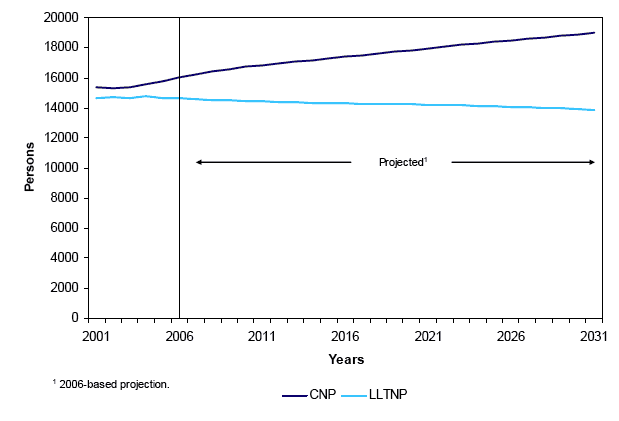
1.1 Main Points
A summary table of the percentage change in Population and Household Projections in Scotland’s National Parks and Scotland, 2006-2031 can be found in Annex A
Total Population
1.2.1 The population projection for the years 2006 to 2031 is illustrated in Figure 1.1 and summarised in Table 1.1. The population of CNP is projected to increase by around 18 per cent from 16,040 in 2006 to 18,990 in 2031. The population of LLTNP is projected to decrease by 5 per cent, from 14,630 in 2006 to 13,890 in 2031.
Figure 1.1: Projected population of CNP and LLTNP, 2006-2031

Age Structure of Cairngorms National Park
1.2.2 Figure 1.2a and Figure 1.2b illustrate the changing age structure of CNP. In 2006 there is a peak between ages 55 and 70 and, as these people grow older, by 2031 it is projected that almost 3 per cent of the population will be aged 90 and above. The number of people aged 20 and under is also expected to increase.
Figure 1.2a: Estimated population by age and sex, CNP, 2006
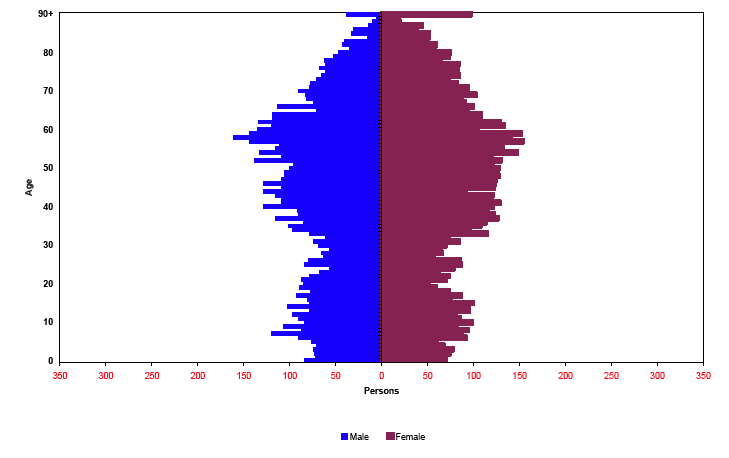
Figure 1.2b: Projected population by age and sex, CNP, 2031
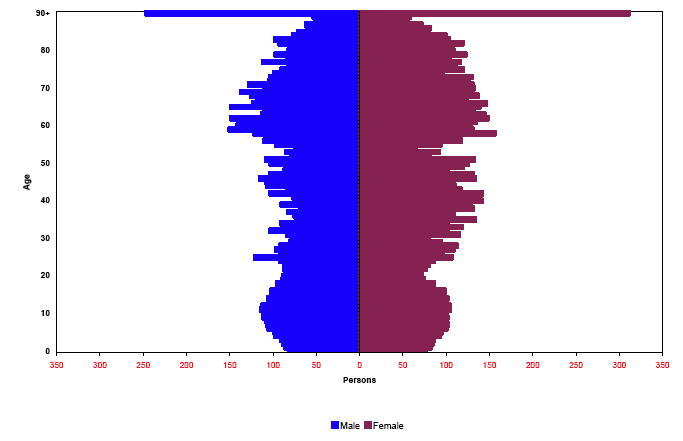
1.2.3 The population of CNP is projected to increase by 18 per cent between 2006 and 2031. As Figure 1.3 shows, the number of people aged 65 and over is projected to increase by 75 per cent.
Figure 1.3: The projected percentage change in CNP’s population by age group, 2006 - 2031
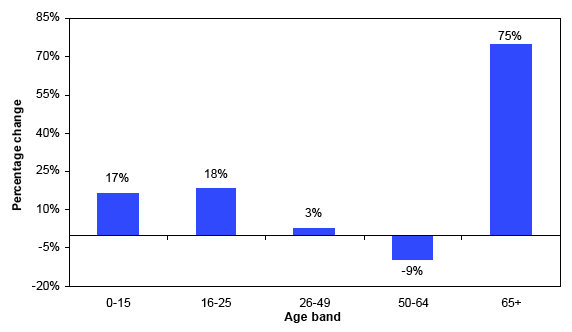
1.2.4 The figures in Table 1.2a show that between 2006 and 2031 the number of children aged under 16 is projected to increase by approximately 17 per cent from 2,720 to 3,180.
1.2.5 Figure 1.3 and Table 1.2a also show a decrease in the number of 50-64 year olds by 2031. During the same period, however, the number of people of working age is projected to increase from 9,490 to 10,430 (around 10 per cent) and the number of people of pensionable age is projected to rise considerably from 3,830 to 5,380 - an increase of around 41 per cent.
1.2.6 The figures from Table 1.2a take into account the increases in the state pension age which will increase from 60 to 65 for women between 2010 and 2020, and then from 65 to 66 for both sexes between 2024 and 2026.
1.2.7 The changing structure of the population is likely to be driven by age structure of the existing population rather than the age structure of migrants, because although CNP is gaining people of retirement age, there are also expected to be approximately 50 children moving into the area each year.
Age Structure of Loch Lomond and the Trossachs National Park
1.2.8 Figures 1.4a and Figure 1.4b illustrate the changing age structure of LLTNP. In 2006 the population peaks between ages 50 and 60 and again ageing means that, in 2031, the largest group is aged 90 and above and, within that age group, the majority is female.
Figure 1.4a: Estimated population by age and sex, LLTNP, 2006
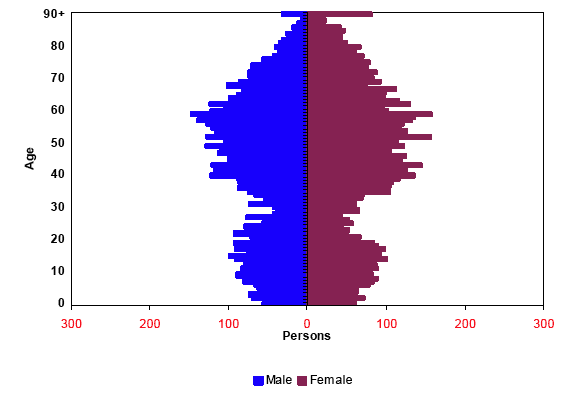
Figure 1.4b: Projected population by age and sex, LLTNP, 2031
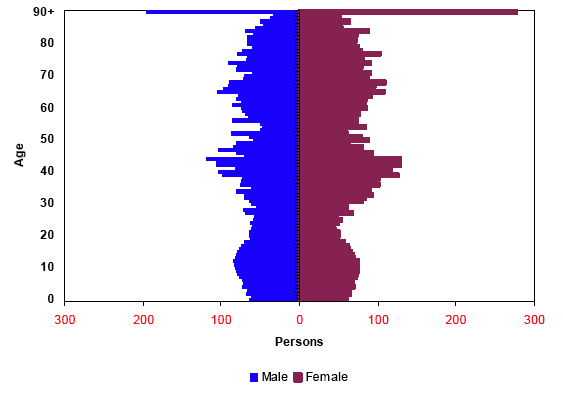
1.2.9 The population of LLTNP is expected to decrease by around 5 per cent between 2006 and 2031, from 14,630 to 13,890. As Figure 1.5 illustrates, the number of 50 to 64 year olds is projected to decrease notably during this period whilst the number of people aged 65 and over is projected to increase — by 43 per cent.
Figure 1.5: The projected percentage change in LLTNP’s population by age group, 2006 — 2031
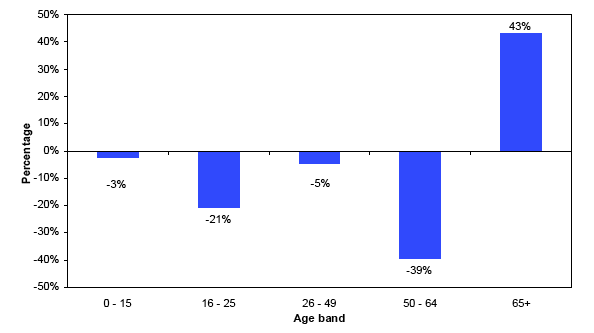
1.2.10 Figure 1.5 shows, and Table 1.2b summarises, that between 2006 and 2031 the number of people of working age will fall from 8,800 to 7,620. The number of people who qualify for state pension, which is currently approximately 3,440, is projected to rise to 3,940.
1.2.11 These figures again take into account the changes to state pension ages between 2006 and 2031.
1.2.12 The changing age structure of LLTNP is likely to be driven by age structure of the existing population rather than the age structure of migrants. The figures suggest that in LLTNP there is out migration of people aged 50 and above.
Components of Change for Cairngorms National Park
1.2.13 Figure 1.6 shows estimated net migration and natural change (births minus deaths) in the CNP between 2001 and 2006, and projected net migration and natural change between 2006 and 2031. The number of deaths is projected to continue to exceed the number of births (giving negative natural change), although the gap between births and deaths closes slightly between 2017 and 2020.
Figure 1.6: Estimated and projected natural change (births minus deaths), net migration, and net change (net migration minus natural change) in CNP, 2001 — 2031
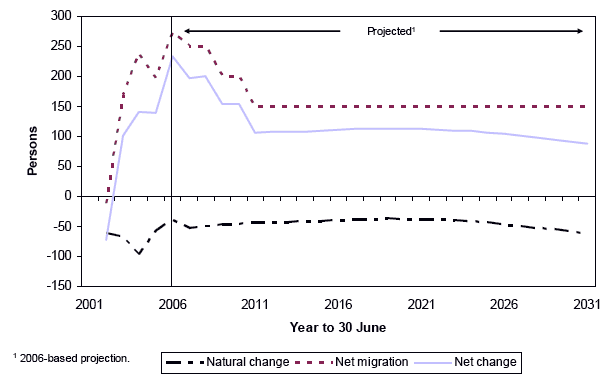
1.2.14 During the projected period there will continue to be positive net migration into CNP. In 2011 net migration is projected to settle at +150 and remain at this annual level for the rest of the period. The increase in the total population in CNP between 2006 and 2031 is due to net in-migration.
Components of Change for Loch Lomond and Trossachs National Park
1.2.15 Figure 1.7 shows that, in Loch Lomond and the Trossachs National Park throughout the period 2006 to 2031, there are projected to be more deaths than births (negative natural change). The gap between births and deaths closes slightly between 2018 and 2020.
Figure 1.7: Estimated and projected natural change (births minus deaths), net migration, and net change (net migration minus natural change) in LLTNP, 2001 — 2031
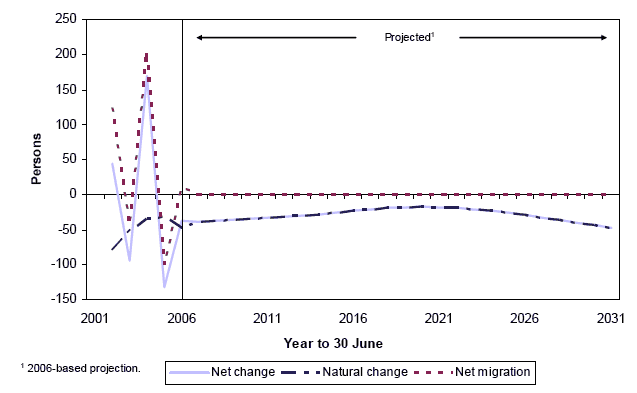
1.2.16 During 2007 net migration is expected to reach zero and remain at zero throughout the rest of the projected period, therefore the decrease of the population in this period is due to natural change.
1.3.1 These population projections were produced using the demographic component method using a single year projection model. That is, a projection made by sex and single year of age for each future year. The projection starts with population estimates for the base year, disaggregated by single year of age, sex and area. Assumptions about future fertility, mortality and migration are then used to project the future population. In this case the areas for which the population was projected were Cairngorms National Park (CNP), Loch Lomond and the Trossachs National Park (LLTNP) and the Rest of Scotland. Results for the Rest of Scotland are not included, but projections for this area were produced to ensure consistency with the National Population Projections for Scotland.
Base population
1.3.2 The National Park base populations were built up from the General Register Office for Scotland’s mid-2006 data zone populations. Data zones are the standard small area geography used by the Scottish Government. In general they have populations of between 500 and 1,000 residents. Data zone boundaries do not exactly match National Park boundaries and so, for the purposes of these projections, data zones in which 80 per cent or more of the population lay outside the National Park boundaries have been excluded. A full list of the data zones used can be found in Annex B.
Fertility, mortality and migration
1.3.3 For National Park areas, the fertility and mortality rates assumed in the national population projections, have been adjusted to take account of local variations observed in the five year period preceding the projection. For migration, the long term assumptions were calculated using 5 year averages of migration in and out of the National Park areas. These averages were then scaled to match the migration assumptions used in the national projections. Short term assumptions were calculated by moving between the 2005/06 migration estimate and the long term assumption at the same rate as the national figures changed.
Projections software system
1.3.4 The software used to produce these National Park population projections is POPGROUP which is owned by the University of Manchester.